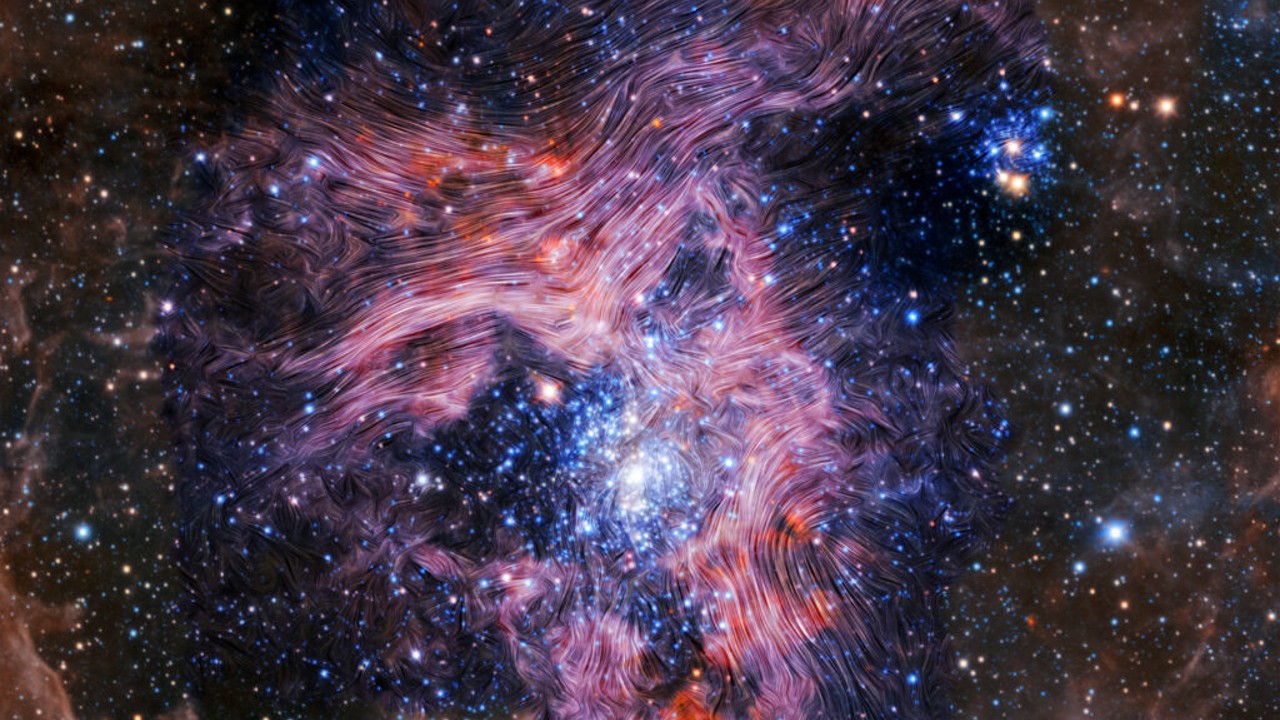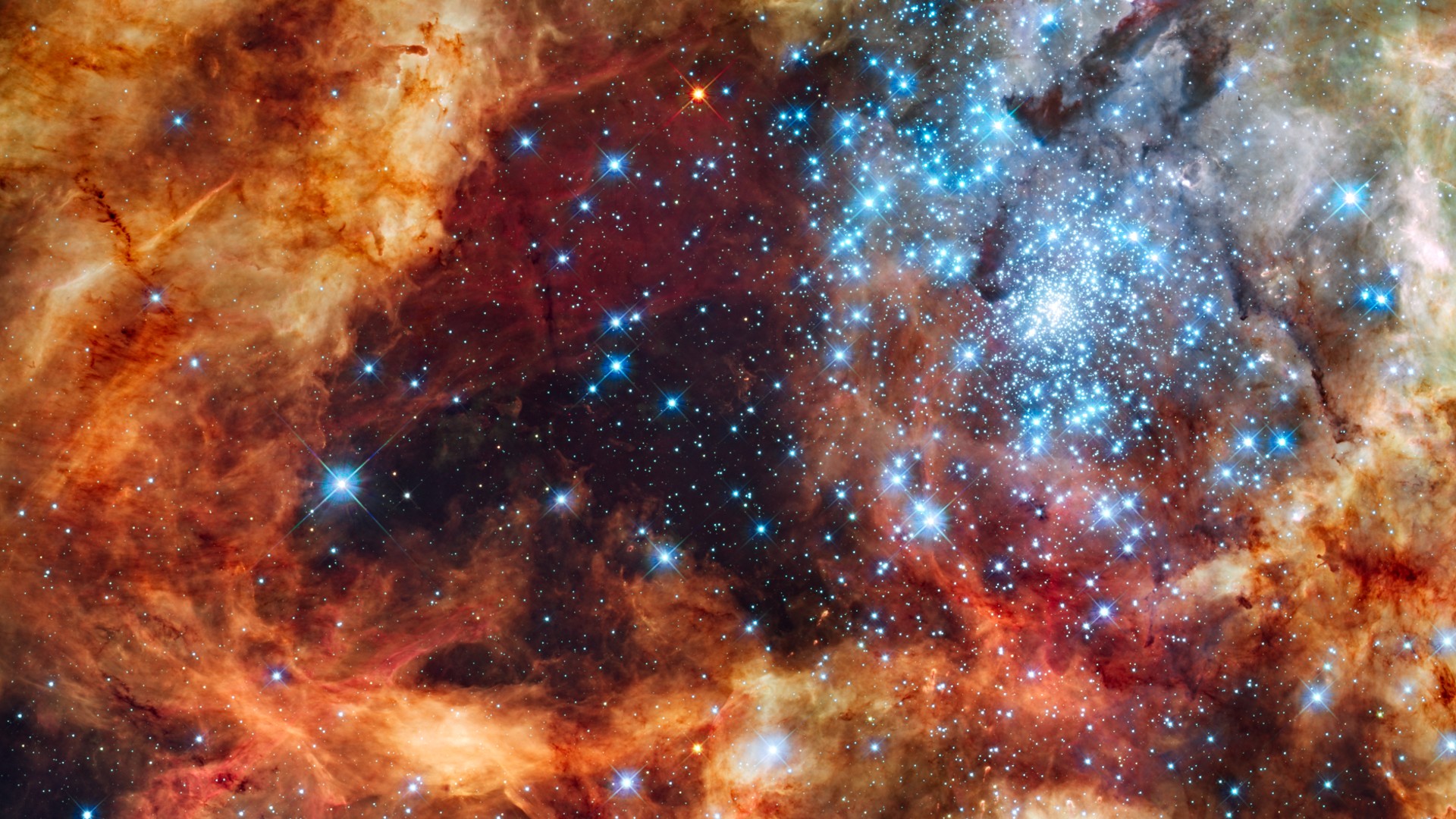'Weird' game of cosmic tug-of-war in the Tarantula Nebula weaves up new stars
The region is home to some of the hottest and most massive stars that astronomers have discovered to date.

The strange behavior of the Tarantula Nebula and its continued existence could be the result of powerful magnetic fields at its heart.
The Tarantula Nebula, officially known as 30 Doradus, is a region of star-forming gas at the heart of the Large Magellanic Cloud, a galaxy close to the Milky Way ablaze with "stellar nurseries" giving birth to baby stars.
A large amount of energy radiates out of the Tarantula Nebula from R136, the massive star cluster near its center. The region extending 82 light-years out from R136 is strange, however, as it displays a lower gas pressure than would be expected alongside the intense stellar radiation from R136, meaning these gases aren't expanding and radiating outward as much as what's typically observed in similar star-forming regions. Additionally, the mass in this region seems too low to maintain its stability.
These new findings could indicate that the key to the longevity of this region is its complex magnetic fields, which constrict these gases in some areas and allow it to escape in others, something NASA referred to as "a bit weird" in a recent statement.
Related: Astronomers image the star-birthing web of a cosmic Tarantula Nebula
At just around 161,000 light-years from our solar system, the Tarantula Nebula is both the largest and brightest stellar nursery among the galaxies nearest to the Milky Way, also called the Local Group.
The core of the Tarantula Nebula has been hollowed out into a massive cavity by the intense radiation blasted out by young hot stars, which can be identified by their bright blue glow. The region also happens to be home to some of the hottest and most massive stars that astronomers have discovered to date.
Get the Space.com Newsletter
Breaking space news, the latest updates on rocket launches, skywatching events and more!
In much of this region, researchers found, the magnetic fields are strong enough to resist turbulence, meaning they help the gas in the Tarantula Nebula not undergo gravitational collapse. This holds the cloud's structure intact, but by preventing the collapse of dense regions of gas, it hinders the birth of stars.
In areas in which the field is weaker, however, gas is able to escape and inflate shells of material. As the mass of these shells increases by gathering material, star formation can then progress within them.

The interplay of gravity and magnetic fields in the region was observed using the Stratospheric Observatory for Infrared Astronomy (SOFIA) High-resolution Airborne Wideband Camera Plus (HAWC+) instrument.
The Tarantula Nebula has been the subject of intense study by astronomers due to the fact that it has a chemical composition that strongly resembles more distant galaxies that are seen at a time of intense star formation called "cosmic noon."
The Tarantula Nebula is also birthing stars at a rate that vastly out-paces the star formation in the Milky Way. This starburst activity also mimics rates of stellar creation at cosmic noon, which occurred between 10 billion and 11 billion years ago, just around 3 to 4 billion years after the Big Bang.
Astronomers will continue to observe this fascinating region of the Large Magellanic Cloud using the Hubble Telescope and the James Webb Space Telescope, using it as a proxy for more distant early galaxies attempting to unlock the secrets of the infant universe.
The research is described in a paper published in the Astrophysical Journal.
Join our Space Forums to keep talking space on the latest missions, night sky and more! And if you have a news tip, correction or comment, let us know at: community@space.com.

Robert Lea is a science journalist in the U.K. whose articles have been published in Physics World, New Scientist, Astronomy Magazine, All About Space, Newsweek and ZME Science. He also writes about science communication for Elsevier and the European Journal of Physics. Rob holds a bachelor of science degree in physics and astronomy from the U.K.’s Open University. Follow him on Twitter @sciencef1rst.









